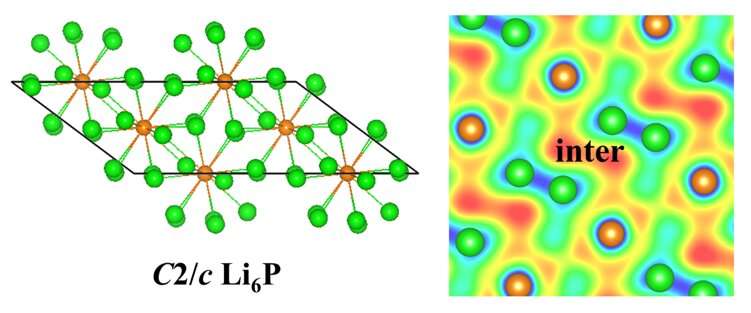March 20, 2019 feature
Study investigates pressure-induced superconducting transition in electrides

Researchers at Northeast Normal University, in China, and University of the Basque Country, in Spain, have recently carried out a study investigating the superconducting transition of electrides. The researchers observed that a pressure-induced stable Li6P, identified by first-principles swarm structure calculations, can become a superconductor with a considerably high superconducting transition temperature.
"Considering the wide potential applications of superconducting materials, the understanding of high-temperature superconductors is a key scientific challenge in condensed matter physics," Aitor Bergara and Guochun Yang, two of the researchers who carried out the study, told Phys.org, via email.
Electrides are ionic compounds in which most electrons reside at interstitial regions of the crystal and behave like anions. Due to their structural peculiarity, these compounds have interesting physical properties. For instance, the magnitude and distribution of their interstitial electrons can be effectively modulated, either by adjusting their chemical composition or external conditions, such as pressure.
Overall, electrides are very poor superconductors. For example, the experimentally observed superconducting transition temperature of a canonical electride [Ca24Al28O64]4+ (4e-)4 is ~0.4 K. On the other hand, it is now well-known that, under high pressure, alkali metals can easily lose their outer orbital electrons and form electrides.
"Interestingly, pressure-induced lithium (Li) electride is metallic," Bergara and Yang said. "Additionally, phosphorus (P) presents a moderate electronegativity, so that they can trap some electrons in Li-rich Li-P compounds, while the remaining electrons may remain at interstitial regions. Thus, as we are predicting is this work, it would be possible to adjust the morphology of interstitial electrons by changing the ratio of Li and P and, therefore, obtain compounds with novel electronic properties. For example, according to our calculations, Li 6 P electride is predicted to have a superconducting transition temperature of 39.3 K, breaking the existing record among the electrides."
Predicting the atomic structure of materials from first principles (based only on their composition), is an extremely challenging task. It typically requires classifying a huge number of energy minima on a multidimensional energy surface lattice. In recent years, researchers have introduced several computation methods that can speed up this process, one of which is called CALYPSO.
"In our study we have used the Calypso program developed by Yanming Ma and his colleagues at Jilin University, which implements a particle swarm optimization algorithm to determine the preferred crystal structures, just fixing the Li:P ratios and pressure as the only starting inputs," Bergara and Yang explained. "Once the most stable structures are identified we have characterized their physical properties. For example, we have explored their superconducting properties within the McMillan-Allen-Dynes approximation."
In their study, Bergara, Yang and their colleagues reported that a pressure-induced stable Li6P electride can become a superconductor with a predicted superconducting transition temperature of 39.3K; the highest predicted so far in known electrides. They found that the compound's interstitial electrons, with dumbbell-like connected electride states, play a dominant role in this superconducting transition.
"Our prediction not only breaks the superconducting transition temperature record in the electrides, but also allows a better understanding of these materials," Bergara and Yang said.
According to the researchers' predictions, other Li-rich phosphides, such as Li5P, Li11P2, Li15P2, and Li8P, could also be superconducting electrides, yet their Tc is expected to be lower. This recent study by Bergara, Yang and their colleagues could pave the way for further research exploring high-temperature superconductivity in similar binary compounds.
"We believe that research into superconducting electrides has just begun," Bergara and Yang said. "There is still a lot to be explored, for example, the analysis of the superconducting mechanism in novel electride compounds, especially under high pressure. As we have shown in this article, an effective way to design such superconducting materials is to explore metallic electride compounds formed between weak electronegative and strong electropositive elements."
More information: Ziyuan Zhao et al. Predicted Pressure-Induced Superconducting Transition in Electride Li6P, Physical Review Letters (2019). DOI: 10.1103/PhysRevLett.122.097002
Yanchao Wang et al. Crystal structure prediction via particle-swarm optimization, Physical Review B (2010). DOI: 10.1103/PhysRevB.82.094116
Journal information: Physical Review Letters , Physical Review B
© 2019 Science X Network





















